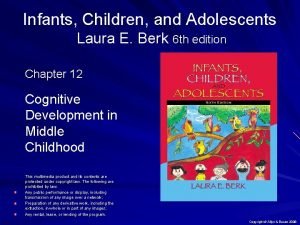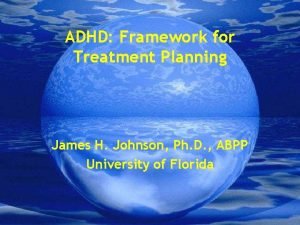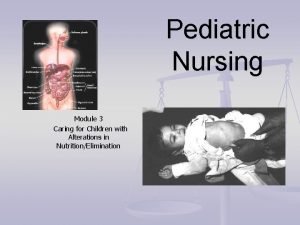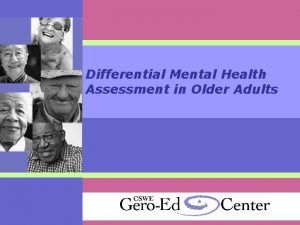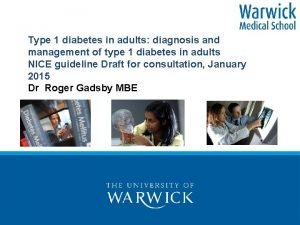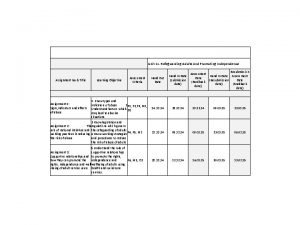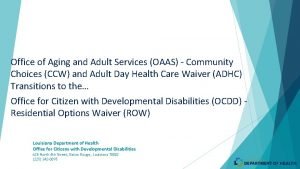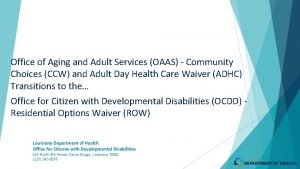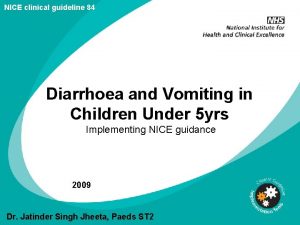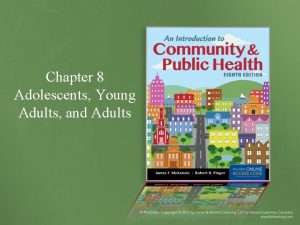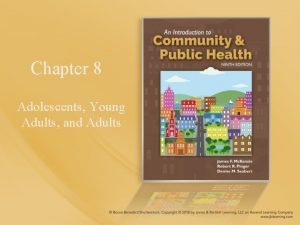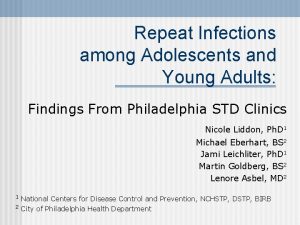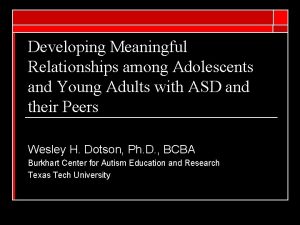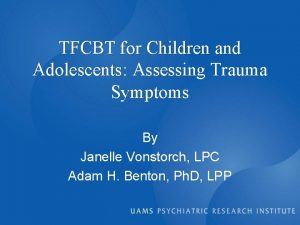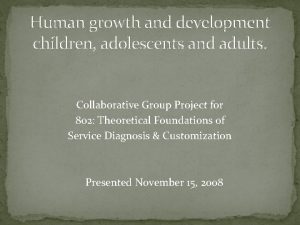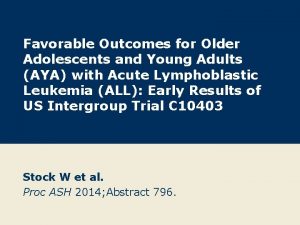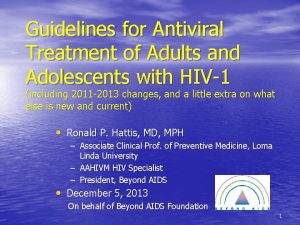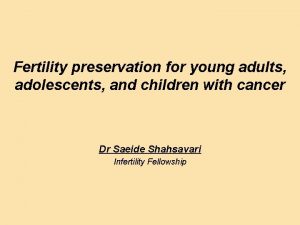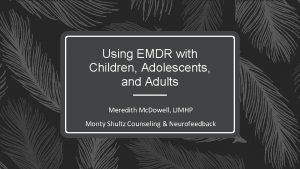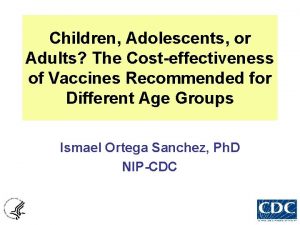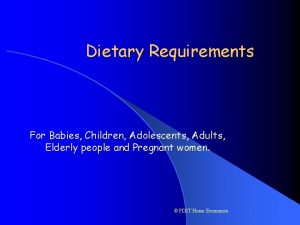Treatment outcomes among children adolescents and adults on
















- Slides: 16

Treatment outcomes among children, adolescents, and adults on treatment for tuberculosis in two metropolitan municipalities in Gauteng Province, South Africa Kaitlyn M. Berry, Carly A. Rodriguez, Rebecca Berhanu, Nazir Ismail, Lindiwe Mvusi, Lawrence Long, Denise Evans Johannesburg DRC Webinar 2 -4 pm 7 th Oct 2020

Background <5 10 -14 15 -19 20 -24 25 -49 ≥ 50 years Increased risk Lower treatment success rates Difficult to diagnose and treat More difficult to treat - more complex disease/AEs Recent transmission Vulnerable population with unique needs Reports are conflicting Poorer adherence to treatment vs. adults “adolescents (10 -19 years) have better treatment outcomes, less death, and less severe disease” High rates of default and treatment failure

Setting • SA has a high incidence of TB - 520 per 100, 000 population (2018) • Gauteng Province – most populous of the 9 provinces in SA. • Greatest proportion of TB and HIV co-infection, with 68% of TB patients estimated to have HIV. • 16% diagnosed; 91% started treatment (DHB 2018/19) Number of clients (5 years and older) with diagnosed DS-TB versus the number started on treatment, by province, 2018/19 National DS-TB client treatment success rate by province, 2017

Background How TB outcomes differ across the full age spectrum within the same setting?

Aim This study aimed to describe treatment outcomes among children, adolescents, young adults, and older adults on treatment for TB in two metropolitan municipalities in Gauteng Province, South Africa.

Methods • • • Retrospective – ETR Initiated treatment for DS-TB 01/2010 – 12/2015 Confirmed TB diagnosis – ETR 2 (RHZE) and 4 (RH) – not INH prophylaxis Removed duplicates Excluded • Missing age • Known drug-resistance • Transferred in to TB care • Age categories <10 (children) 10 -14 15 -19 20 -24 Podewils et al. BMC Public Health (2015) 15: 765 25 -49 and ≥ 50 years

Methods Statistical analysis • Treatment outcomes as reported in ETR • Among patients assigned a treatment outcome • All-cause mortality or LTFU (treatment interruption of ≥ 2 months) • Within 10 months after treatment initiation • Cox proportional hazard models • Kaplan-Meier survival curves • Estimate LTFU - Competing risk of death (Fine and Grey) • Sensitivity analysis • All patients who had a treatment outcome assigned in ETR (regardless of when the outcome occurred).

Patient Characteristics 65% Initiated in the City of Johannesburg 45% Female 94% New TB cases 84% Pulmonary TB 37% Smear positive* Xpert MTB/RIF increased from 0% in 2010 to 63% by the end of the study.

Case definition Bacteriologically confirmed Clinically diagnosed Missing/Unknown HIV status Total Positive, on ART All <10 N = 182890 N = 18259 126360 1265 (69. 09%) (6. 93%) 29658 9309 (16. 22%) (50. 98%) 26872 7685 (14. 69%) (42. 09%) 10 – 14 N = 2032 1130 (55. 61%) 467 (22. 98%) 435 (21. 41%) 15 – 19 20 – 24 N = 3931 N = 11686 3086 9247 (78. 50%) (79. 13%) 418 1224 (10. 63%) (10. 47%) 427 1215 (10. 86%) (10. 40%) 118326 3325 (64. 70%) (18. 21%) 71421 2016 (60. 35%) (60. 63%) 1000 (49. 21%) 643 (64. 30%) 1386 (35. 26%) 853 (61. 54%) 5711 (48. 87%) 3084 (54. 00%) 25 – 49 ≥ 50 N = 123363 N = 23619 94042 17590 (76. 23%) (74. 47%) 15126 3114 (12. 26%) (13. 18%) 14195 2915 (11. 51%) (12. 34%) 93818 (76. 05%) 56637 (60. 36%) 13086 (55. 40%) 8188 (62. 57%) 60. 35% of HIV positive cases were on ART 25. 15% not on ART 14. 50% unknown ART status

Treatment success = 84% Characteristics Age at start of treatment (years) Results Proportion with outcome [Death] <10 (children) Adjusted HR Proportion with and 95% CI outcome [LTF] Adjusted HR and 95% CI Adjusted sub-HRb and 95% CI 209 (1. 20%) 0. 23 (0. 20 -0. 26) 631 (3. 63%) 0. 62 (0. 56 -0. 68) 0. 64 (0. 58 -0. 70) 10 -14 (young adolescents) 52 (2. 72%) 0. 48 (0. 37 -0. 63) 60 (3. 14%) 0. 53 (0. 41 -0. 68) 0. 54 (0. 42 -0. 69) 15 -19 (older adolescents) 109 (2. 96%) 0. 62 (0. 51 -0. 75) 224 (6. 09%) 1. 05 (0. 92 -1. 21) 1. 07 (0. 93 -1. 22) 20 -24 (young adults) 389 (3. 62%) 0. 71 (0. 64 -0. 78) 890 (8. 29%) 1. 43 (1. 33 -1. 54) 1. 44 (1. 34 -1. 55) 6713 (5. 88%) 1. 00 7046 (6. 17%) 1. 00 2437 (11. 00%) 2. 13 (2. 03 -2. 23) 1150 (5. 19%) 0. 85 (0. 80 -0. 91) 0. 82 (0. 77 -0. 87) 25 -49 (adults) ≥ 50 (older adults)

Results Patients with HIV on ART had a lower risk of LTFU, but increased risk of death when compared to patients without HIV. Characteristics HIV status Positive on ART Positive not on ART Positive ART status unknown Negative HIV status unknown Proportion with outcome [LTF] 3435 (5. 14%) 2416 (7. 90%) 951 (6. 10%) 1971 (5. 09%) 1498 (6. 90%) Characteristics HIV status Positive on ART Positive not on ART Positive ART status unknown Negative HIV status unknown Adjusted HR and 95% CI 0. 91 (0. 86 -0. 96) 1. 57 (1. 47 -1. 68) 1. 23 (1. 13 -1. 34) 1. 00 1. 43 (1. 33 -1. 53) Adjusted sub-HRb and 95% CI 0. 90 (0. 85 -0. 95) 1. 52 (1. 42 -1. 62) 1. 19 (1. 10 -1. 29) 1. 00 1. 40 (1. 31 -1. 51) Proportion with Adjusted HR and outcome 95% CI [Death] 4056 (6. 07%) 1. 67 (1. 58 -1. 78) 2267 (8. 35%) 2. 51 (2. 33 -2. 70) 1243 (7. 98%) 2. 40 (2. 21 -2. 61) 1155 (2. 99%) 1. 00 1188 (5. 47%) 1. 77 (1. 62 -1. 92)

Study limitations • Issues related to accuracy and completeness of national data are well described. • Data on age and sex = reliable. HIV, ART, treatment outcomes are not. • Missingness – outcomes + treatment supervision • Earlier versions of ETR did not have provision for Xpert MTB/RIF (entered as smear) or ART start date (2014 -2015) • De-identified – not able to link to NHLS, vital statistics register • All-cause mortality – not mortality due to TB.

Conclusions • Young adults in urban areas of Gauteng Province experience a disproportionate burden of LTFU and low coverage of ART among co-infected patients. • This group should be targeted for interventions aimed at improving clinical outcomes and retention in both TB and HIV care.

Conclusions • 2009 -2013; n=23, 737 patients • HIV co-infection; 18. 5% 10 -14, 12. 9% 15 -19, 33. 1% 20 -24 • Compared to 10 -14, those 15 -19 (a. OR 1. 75) and 20 -24 (a. OR 1. 96) increased risk of LTFU. • TB care needs to be tailored to the needs of 10 -14 (reference) young people to improve patient retention. 15 -19 (OR 1. 93) and 20 -24 (OR 2. 58) Mulongeni P, Hermans S, Caldwell J, Bekker LG, Wood R, Kaplan R. HIV prevalence and determinants of loss-to-follow-up in adolescents and young adults with tuberculosis in Cape Town. PLo. S One. 2019 Feb 5; 14(2): e 0210937.

Conclusions • As people with HIV experience longer life expectancy, health care systems need to prepare for the increase of TB in ageing populations that are more difficult to treat and have worse outcomes.

Acknowledgements This study has been made possible by the generous support of the American People and the President’s Emergency Plan for AIDS Relief (PEPFAR) through USAID under the terms of Cooperative Agreements AID-674 -A-12 -00029 and 72067419 CA 00004 to HE 2 RO. The contents are the responsibility of the authors and do not necessarily reflect the views of PEPFAR, USAID or the United States Government. The contents of the article are the responsibility of the authors and do not necessarily reflect the views of USAID or the US government.
 Infant child and adolescent berk 8th edition chapter 1
Infant child and adolescent berk 8th edition chapter 1 Lara berk
Lara berk Adhd treatment plan goals examples
Adhd treatment plan goals examples Pyloromyotomy post op nursing care
Pyloromyotomy post op nursing care Difference between dating and courting
Difference between dating and courting Mental health and older adults
Mental health and older adults Mental health and older adults
Mental health and older adults The art and science of helping adults learn
The art and science of helping adults learn Type 1 diabetes in adults diagnosis and management
Type 1 diabetes in adults diagnosis and management Unit 11 safeguarding adults and promoting independence
Unit 11 safeguarding adults and promoting independence Office of aging
Office of aging Office of aging and adults services
Office of aging and adults services Nice guidelines diarrhoea and vomiting in adults
Nice guidelines diarrhoea and vomiting in adults Planning phase in nursing process
Planning phase in nursing process Planning goals and learning outcomes
Planning goals and learning outcomes Collaborative interventions nursing
Collaborative interventions nursing Learning outcomes of direct and indirect speech
Learning outcomes of direct and indirect speech

